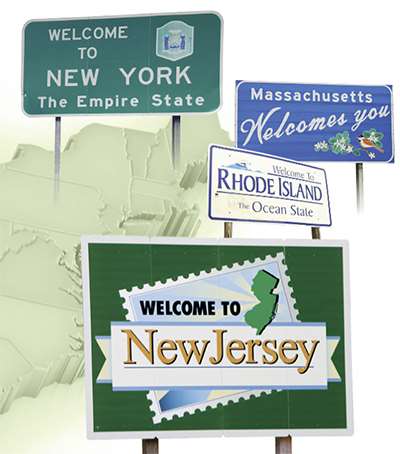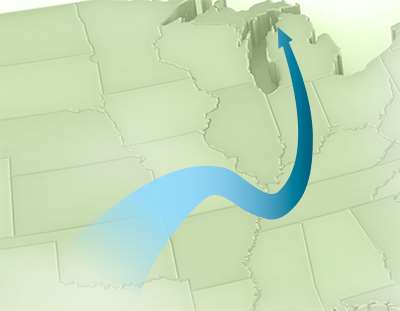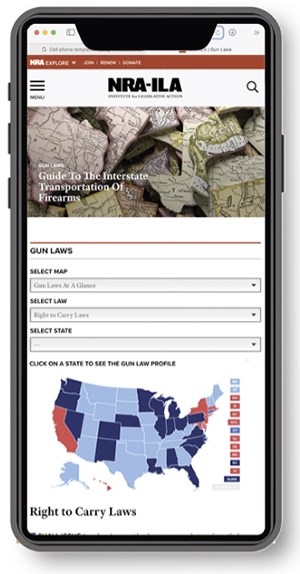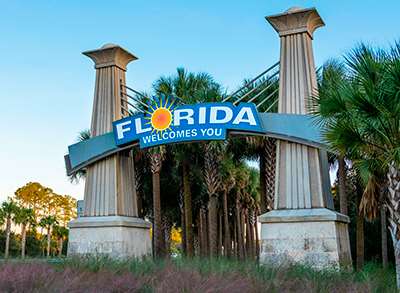
Have gun, will travel. If you’re an older reader of this magazine, you might recognize that phrase as being the name of an old television series starring a very young Richard Boone back in the late 1950s and early ’60s. Now, however, it has much greater meaning, as millions upon millions of law-abiding Americans throughout the country carry a firearm for self-defense and understandably like to take their guns with them when they are away from home; after all, it’s better to have one and not need it than to need one and not have it, right?
Given the recent U.S. Supreme Court decision in New York State Rifle & Pistol Association v. Bruen, in which Justice Clarence Thomas wrote for the majority that restrictive carry laws were making the Second Amendment a “second-class” right, you’d think traveling with a firearm would be no problem; however, because of a patchwork of different state and municipal laws all across the fruited plains—some Second Amendment friendly and some most decidedly not—it’s still not as simple as dropping your Glock or S&W into a holster and hitting the road for work, fun or whatever reason you might travel. Those anti-gun laws, and the politicians who support them, pose a grave danger to the traveling gun owner who doesn’t do his or her homework before departure.

Case Study: A Hero Under Fire
When Lloyd Muldrow went from his Virginia home to nearby Maryland, he had no idea his entire life—a life largely spent serving his country—was about to be turned upside down.
A resident of Virginia, Muldrow spent 15 years in the U.S. Marine Corps, first as a presidential security guard, then in the infantry. He spent many of those years as a weapons expert and hand-to-hand combat instructor. Consequently, he’s one of those guys who runs toward trouble instead of away from it.
Muldrow had gone to Baltimore, Md., for a family birthday party at a club. He had left his firearm—he’s carried a gun daily both on and off work for 40 years—in the car. When he and his companions were ready to leave, Muldrow had gone to pull the car around to pick up the others, and while doing so had put his firearm back on his belt.
“Then I saw people running to the door and knew there was a commotion going on,” Muldrow said in an exclusive interview with America’s 1st Freedom. “I was like, ‘Woah, I need to go in and get my family out of there.’ As soon as I walked in the door, I saw my friend bleeding from the forehead, and to me it looked like he had a bullet wound right in the middle of his forehead.”
Muldrow then saw a man nearby with a gun in his hand. Muldrow charged the assailant, struck him, grabbed him by the arm of his gun hand, took him down to the ground and swiped his gun away.
“Once I took him down, no more than 10 seconds later, the police were on top of us,” Muldrow said. “Engaging with the police officer, the law states that you need to let them know you have a firearm on you. At that point, if they had found the firearm without me saying that, then I’m in the wrong. That’s what my interpretation of the law is. The reason I even had the gun is because I was leaving. I was transporting it at this time.”
Muldrow explained to the officers that he has a valid Virginia concealed carry license, as well as Department of Criminal Justice System certification. He further explained that he was a former military police officer, had been infantry and had carried a firearm all around the world.
“The only thing that came out of that sergeant’s mouth was, ‘Maryland doesn’t recognize Virginia. There is no reciprocity. Lock him up,’” Muldrow said.
Interestingly, other officers at the scene, aside from the one in command, considered Muldrow to be a hero. They realized that he had saved them from having to face an armed man when entering the building.
“Every officer there literally rolled out the red carpet for me,” he said. “It was the supervisor on the scene who made the immediate decision. Even the officer that took me down to the jail said to the officers there, ‘Look guys, this guy just saved us from having to do a whole lot of paperwork and possibly killing someone,’ because not only did I save my friend’s life, I saved the life of that guy that I disarmed.”
Muldrow faced charges of carrying a firearm within 100 feet of a dwelling that serves alcohol, which could cost him a year in prison. What upset Muldrow the most is the unfairness of the entire situation.
“Some people say ‘hero,’ some people say ‘good Samaritan,’ I say Marine, or veteran,” Muldrow said. “This is what we do and we don’t get the credit for it. This is what we’re trained to do.
“I’m not going to take a plea deal. If an American cannot stand up to the enemy, both foreign and domestic, then what are they teaching us here? You’re going to tell me you’re going to lock me up for a year because I carried a gun in Maryland. I’d rather be a POW [prisoner of war]in another country than be locked up in my own country because I carried a firearm from Virginia to Maryland. We, as veterans, as humans, as Americans, have a right to defend ourselves.”
Just before this article went to print, Muldrow received a “probation before judgment” decision in Baltimore Circuit Court. This decision waives a guilty plea. Muldrow went free; the downside is this case can not be used to create a precedent.

A Widespread Problem
Muldrow is just one example.
Countless Americans face prosecution and even persecution each year because they’ve gotten caught up in unjust laws while traveling to different parts of the country from their home state; in fact, the patchwork of different gun regulations can make planning a trip a nightmare for those who are trying to stay on the right side of the law. Just try this exercise: Plan a trip to a completely different part of the country. While mapping out the trip, try to research the gun laws of the states you plan to pass through on the way to your destination.
I did this the year before last when I was planning to travel from my home in Oklahoma to Michigan’s upper peninsula to hunt ruffed grouse. I had dogs and guns along, including my carry pistol and a couple of shotguns.
Missouri laws are similar to Oklahoma’s, so I was good to pass through the Show Me State on my journey; however, the most-direct route took me right through nearly the entire state of Illinois, including through the city of Chicago. With both Illinois and Chicago laws completely non-gun friendly, I decided to reroute through the more gun-friendly states of Kentucky and Indiana. The difference, according to GPS estimates, was I had to travel 1,101 miles instead of 935 and spend nearly 17 hours on the road instead of 14.
The same thing was true when I recently planned a trip from Tulsa to Spokane, Wash. Even taking the most-direct route, the trip is estimated at 24 hours and 17 minutes; however, that route would take me through the anti-gun bastion of Colorado for several hours. Yes, Colorado has reciprocity with Oklahoma, but a closer look into the state’s gun laws revealed that with a law forbidding magazines holding more than 15 rounds, my Glock 17 could get me in trouble. And who knows what the gun laws in Denver and some of the other liberal bastions might be? In the end, I decided not to make the trip rather than worry about the firearms-related logistics or, worse, traveling without protection.
Note that traveling to the East Coast or West Coast is even more problematic. California laws are among the worst on the books. And don’t dare even think about taking your gun through New Jersey without carefully studying the regulations, as horror stories out of the Garden State are plentiful.
 Just ask Brian Fletcher, a utility repairman who, in 2015, traveled with a lawfully owned firearm from his home state of North Carolina to New Jersey to do disaster-relief work following a hurricane. After he volunteered information about the firearm to a police officer in New Jersey, he was arrested and had to post a $25,000 bail to get out of jail the next day. He was charged with “Second Degree Unlawful Possession of a Handgun,” which could have landed him in prison for five years. Fortunately for Fletcher, New Jersey’s then-Gov. Chris Christie (R) pardoned him before he had to spend any more time behind bars.
Just ask Brian Fletcher, a utility repairman who, in 2015, traveled with a lawfully owned firearm from his home state of North Carolina to New Jersey to do disaster-relief work following a hurricane. After he volunteered information about the firearm to a police officer in New Jersey, he was arrested and had to post a $25,000 bail to get out of jail the next day. He was charged with “Second Degree Unlawful Possession of a Handgun,” which could have landed him in prison for five years. Fortunately for Fletcher, New Jersey’s then-Gov. Chris Christie (R) pardoned him before he had to spend any more time behind bars.
Aside from New Jersey, extremely restrictive gun laws in states from Maryland to New York and beyond can land travelers in serious trouble if they don’t do their homework before hitting the road.
What About F O P A and Bruen?
Self-defense is a fundamental right, and the right to use firearms for self-defense is recognized by the Constitution of the United States, the constitutions of 44 states, the laws of all states and by common law. That fact, in contrast to the different and difficult-to-decipher laws from state to state, prompted Congress to pass the Firearms Owners Protection Act (FOPA) back in 1986.
FOPA guarantees the right of a law-abiding American to transport an unloaded firearm between a location where he or she may legally possess it and a destination where he or she may also legally possess it, regardless of state or local laws along the route of travel that might otherwise apply. Under the law, the gun must be cased or otherwise not readily accessible. In vehicles without a trunk, the unloaded firearm must be in a locked container other than the glove compartment or console. Ammunition that is either locked out of reach in the trunk or in a locked container other than the glove compartment or console is also covered by the law.
One problem with that, as America’s 1st Freedom readers are aware, is having a gun unloaded and locked in a case away from ammunition provides very little protection for the traveler who might need quick access to it in an emergency. Another problem is that some state and local governments treat this federal provision as an “affirmative defense” that may only be raised after an arrest, which still likely means a trip to jail and a day (or many more) in court.
Of course, the recent U.S. Supreme Court decision in Bruen, which overturned New York’s restrictive carry-permitting law, could influence when and where lawful Americans can carry a gun in the future. But that doesn’t mean you can simply put on your gun and drive into Camden, N.J., and think you won’t be prosecuted if you’re discovered to be carrying.
In Bruen, the high court struck down New York’s law that required applicants to prove to the government that they have a “good reason” before being issued a permit. Under New York law, possessing a loaded firearm outside one’s home or place of business without a license is a felony punishable by up to 15 years in prison.
Writing for the majority, Justice Clarence Thomas expressed what pro-gun advocates have been saying for years—and what anti-gun politicians feared most: “The constitutional right to bear arms in public for self-defense is not ‘a second-class right, subject to an entirely different body of rules than the other Bill of Rights guarantees. We know of no other constitutional right that an individual may exercise only after demonstrating to government officers some special need.”
Since there’s no other constitutional right that ends at state lines, one might think that the Bruen decision, coupled with the landmark District of Columbia v. Heller (2008) decision that affirmed an individual right to own a firearm for self-defense, might be all that’s needed to carry just about anywhere you want nowadays. But, while Bruen has already had some positive effects on gun laws in a few states, it will take time for cases to make their way through the court system, and many bad laws that run afoul of both Bruen and Heller are still on the books in some states—a few have even been passed since Bruen was decided.
What’s The Solution?
First, the solution to traveling with firearms without being arrested and prosecuted is not to call your buddy who “knows a lot about guns” and ask him if you can carry between your home in the Florida panhandle and your destination in northern Delaware. That’s a sure way to land in hot water. Nor is the solution to assume that since you don’t plan on speeding or breaking any laws, you can simply keep your carry gun loaded and on your person or in your console since you don’t plan to encounter law enforcement. That’s another recipe for disaster, especially if you’re forced to use the gun for self-defense.
One solution—and this is the worst one—is to choose to leave your gun at home in fear of accidentally breaking a law and losing your freedom and your rights over it. In truth, many restrictive gun laws are purposely written in a confusing manner to discourage people from having a firearm in fear they might break the law.

Another equally bad solution is to stubbornly claim the U.S. Constitution protects your right to carry a firearm for self-defense anywhere you go—which is basically what the Second Amendment says when it states, “The right to keep and bear arms shall not be infringed.” Sure, you can ignore current state laws and carry your gun in restrictive states, but the result might not be what you expect. The legal system is slow, litigating a firearms case is quite expensive and being considered a “criminal” for practicing a constitutional right isn’t an enjoyable experience.
Perhaps the best current solution is to thoroughly research the carry laws in every state that you plan to pass through, as well as the other gun laws in those states. Just because a state recognizes your permit doesn’t necessarily mean the gun you plan to take along is legal in that jurisdiction, or even in some municipalities within that state.
While FOPA covers transporting a firearm from state to state, as soon as any gun is carried on or about the person, or placed loaded or readily accessible in a vehicle, state and local laws regarding the carrying of firearms apply. The National Rifle Association’s Institute for Legislative action advises that if you wish to carry or transport firearms in such a manner, you should contact the attorney general’s office in each state through which you might travel to find out exactly what their laws are.
To make travel planning easier, NRA-ILA offers an outstanding “Guide To The Interstate Transportation Of Firearms” that can be accessed online at nraila.org/articles/20150101/guide-to-the-interstate-transportation. The guide covers everything from federal law on transporting firearms to carrying, transporting a gun in a motor vehicle or commercial aircraft and even carrying in national and state parks and wildlife refuges.
The Best Solution
The NRA has long recognized that the current patchwork of state carry laws and reciprocity agreements creates confusion and can make “criminals” out of law-abiding citizens who simply want to exercise a right protected by the U.S. Constitution. That’s why the NRA has, for years, been talking about federal legislation for “national concealed-carry reciprocity.” Such legislation would ensure that those who can lawfully carry concealed in their home state are able to carry concealed in every other state without being considered criminals in anti-gun jurisdictions.
In fact, such legislation has had some congressional support a few times in the past. President Donald Trump (R) even said he’d sign a national reciprocity bill if Congress would pass it and send it to his desk.
“That’s why I have a concealed carry permit and why tens of millions of Americans do, too,” Trump said. “That permit should be valid in all 50 states.”
During that legislative session, the measure, called the “Concealed Carry Reciprocity Act,” passed the U.S. House of Representatives by a vote of 231-198, with six Democrats voting for the measure and 14 Republicans voting against it. Unfortunately, the crucial legislation stalled in the U.S. Senate and never made it to Trump’s desk.
Such a measure will never get passed and signed into law until both the U.S. House of Representatives and the U.S. Senate are once again under control of those who respect the right to keep and bear arms and at such a time when the president of the United States also respects the Second Amendment. President Joe Biden (D), of course, is far more interested in banning America’s most-popular rifle and pushing other restrictions on gun owners than in helping American travelers stay safe when going from state to state.
The old saying, “elections matter,” is especially important for Americans who wish to travel safely and legally with their carry firearms where they can be easily accessed in the case of an emergency.


































